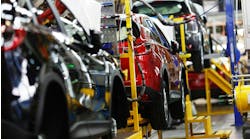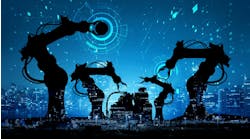3 ways manufacturers can shift to an industrial-AI strategy
Manufacturing has historically trailed other industries in adopting and implementing AI, but 2021 marked a major turning point in this trend. Despite continuing waves of COVID-19 and the pandemic’s ripple effects on supply chains and the market, industrial organizations over the past year actually increased their investments in industrial AI applications by 15%, for a total budget of $16 million, on average, according to a recent independently conducted survey.
While most manufacturers recognize AI as a key business and revenue driver, many also struggle to deploy it in a way that makes it easy to demonstrate ROI. Going forward, executives must take a more targeted approach in how they implement industrial AI—shifting from broader, generic AI models to more precise, fit-for-purpose applications that can notch some quick ROI wins and prove its value.
But making that shift requires a holistic strategy. Here are a few key elements of an industrial AI strategy that can help manufacturers make that transition.
Articulate a vision from the top
Chief digital officers (CDOs) and digital executives are key to driving industrial AI strategy. The key ingredients for making industrial AI successful are: bridging the IT-OT gap, eliminating team and technology silos, phasing out mass data-collection methods in favor of more strategic industrial data management, and utilizing next-generation data historians to make industrial data more easily and widely accessible across the organization.
But none of these changes can be decided on the ground; eliminating silos, after all, can’t be done by the teams or team leaders within those silos. Industrial AI adoption and strategy ultimately start with a vision from the top—namely, from CDOs and digital executives tasked with overseeing their organization’s digital-transformation efforts.
Ramp up knowledge automation
Industrial leaders must accelerate their organization’s adoption of knowledge-automation technologies and intelligence-rich applications. Automated knowledge sharing helps preserve historical domain expertise, ensuring that expertise isn’t exclusive to any one individual or isn’t being trapped in any one silo. This has three benefits:
● It makes the domain knowledge accessible—on demand—across the organization, regardless of team or silo.
● It ensures that domain knowledge isn’t reliant on any single worker, which is doubly beneficial during a time when veteran workers are hitting their retirement and younger employees are joining the Great Resignation.
● It ensures that targeted industrial-AI applications have a guaranteed pool of historical data to leverage, data that isn’t exclusively contained in silos or in the heads of individual domain experts.
Empower industrial data scientists to lead the charge on AI strategy
That aforementioned survey highlighted a major industrial AI strategy gap: While 99% of industrial decision-makers could see how an industrial-AI strategy could generate business value for their organization, only 35% had actually developed and rolled one out. And for the other 65%, the average cost of not having an industrial AI strategy? $10 million.
This is a clear disconnect that poses serious business challenges to any industrial organization. Luckily, it’s also a very solvable one.
Industrial-data scientists are quickly emerging as a new, and currently untapped, element of the industrial workforce. Part domain expert and part analyst, industrial-data scientists are able to leverage their unique middle-ground role in the organization (and the expertise that comes with it) to best create a strategy for maximizing the value of industrial AI. But industrial data scientists need leeway from the top to drive the creation of this strategy.
Reaping value from industrial AI starts with the strategy
Industrial AI is the key to unlocking a smarter, more automated, more optimized plant of the future that can achieve industry’s dual goals of sustainability and profitability. But getting there requires a holistic strategy for moving AI away from generic models trained on broad volumes of plant data to more specific applications that leverage domain expertise for creating quicker business outcomes.
Embracing knowledge-automation technologies, empowering industrial-data scientists, and articulating a vision and culture of change from the top are all key ways industrial organizations can create a strategy for deploying, and reaping quick benefits from, industrial AI.
By Bill Scudder, AspenTech senior vice president and AIoT general manager


